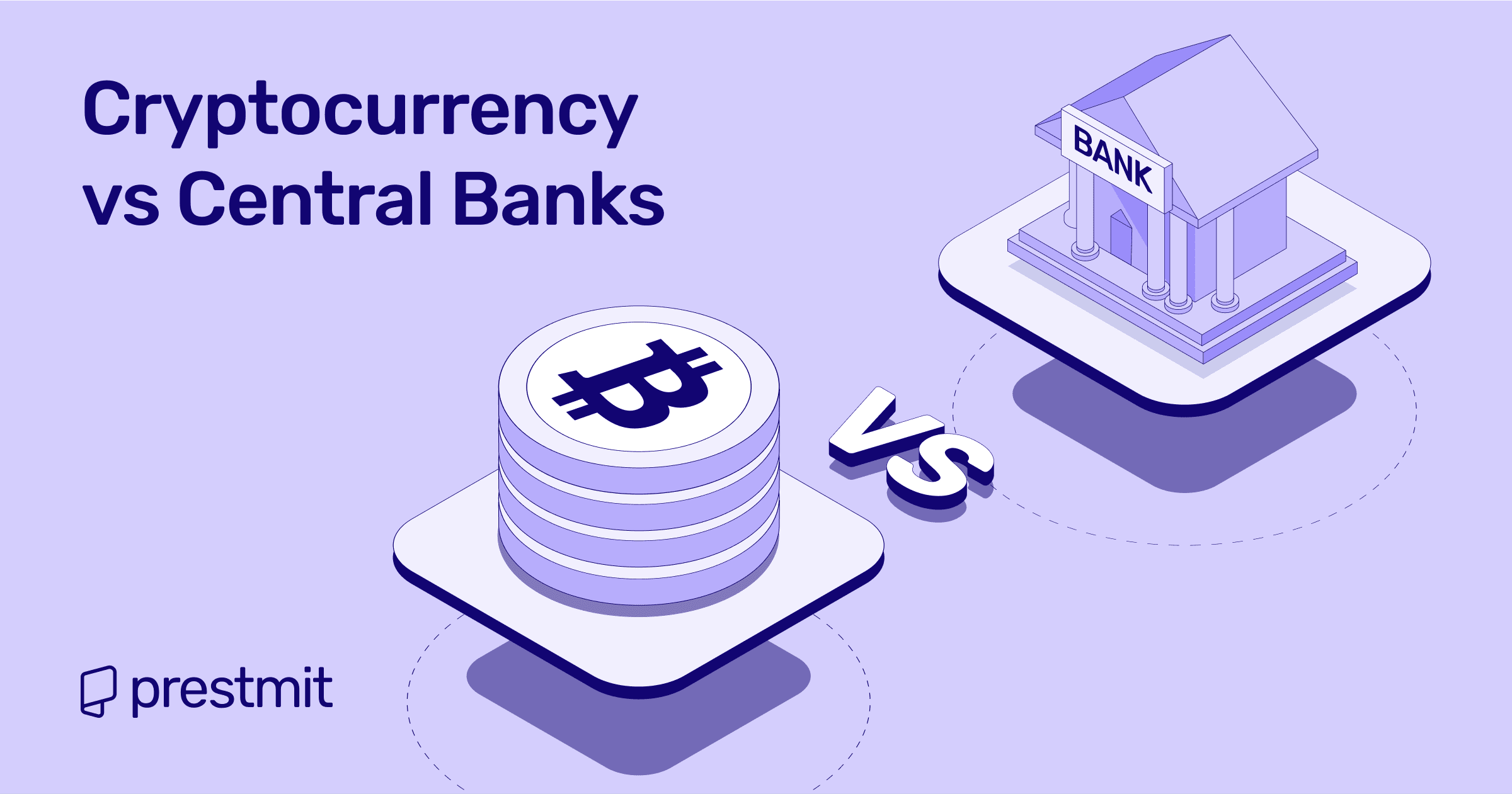Table of Contents
Did you know that Bitcoin, the first cryptocurrency, was created after the 2008 global financial crisis, a crisis partly caused by central banks’ policies. Bitcoin was created as an alternative to a banking system that had just shown its flaws.
Fast forward to today. Cryptocurrencies like Bitcoin have caught the attention of central banks worldwide, forcing them to respond in different ways: Some are regulating them, and some have even banned them outright. As a result of this attention and crypto’s impact on financial systems, people are beginning to wonder if it could actually weaken or even replace central banks.
But before you start picturing bankers crying into their spreadsheets, let’s separate hype from reality first. In this article, I’ll cut through the noise and show you what’s real and what’s myth about crypto and central banks.
Can Cryptocurrency Really Kill Central Banks?

No, despite the hype, cryptocurrencies cannot fully kill central banks. Cryptocurrencies do challenge some aspects of central banking, yes. But they function without central control and currently do not provide the stability, universal acceptance, or regulatory protections needed to fully replace traditional money.
However, because cryptocurrencies operate on decentralized networks, they remove the need for a single authority, and this is the main challenge cryptocurrencies pose to central banks. Even crypto banks, which take advantage of the decentralization and limited supply, cannot match the stability, regulation, and reach of traditional banks.
Central banks could lose some influence over money creation, interest rates, and financial transactions. But in the end, they still control monetary policy, keep economies stable, and provide trust that crypto alone cannot guarantee. So yes, crypto does challenge central banks, but no, it cannot kill them.
Reasons Cryptocurrency Can’t Replace Central Banks
Despite the growing popularity of crypto, several fundamental challenges prevent it from fully replacing central banks:
1. Stability and Trust
People trust central banks because they can be relied on in everyday life. They provide a predictable system and can step in during crises. Cryptocurrencies, on the other hand, are highly volatile. For example, Bitcoin’s price jumped to $64,000 in April 2021 and then fell by more than half to around $30,000 by July of the same year.
2. Regulation and Consumer Protection
Central banks set rules to protect people from fraud and economic shocks. Cryptocurrencies don’t have a central authority, so without proper regulation, investors face risks like hacks, scams, or losing access to their funds.
3. Monetary Policy and Economic Tools
Central banks have tools to manage the economy, like controlling inflation, setting interest rates, or deciding how much money should be in circulation in response to economic conditions. Crypto and crypto banks don’t have these tools built in, making them unreliable for managing an entire economy.
4. Mass Adoption Challenges
While businesses are accepting crypto payments, their adoption is still emerging. In Gemini’s 2025 Global State of Crypto Report, they showed that only about 24% of adults in countries like the U.S., U.K., France, and Singapore have ever used crypto. Compared to the over 70% who still use traditional money, this shows that crypto isn’t widely adopted enough to replace central banks anytime soon.
How Central Banks Are Responding
Central banks around the world are not just sitting, folding their hands, and watching crypto take over either. They are taking influence from crypto and adopting innovation to improve and maintain control over financial systems. They are:
1. Launching Central Bank Digital Currencies (CBDCs)
One of the biggest moves has been the launch of Central Bank Digital Currencies (CBDCs) in various countries. CBDCs are digital forms of a country’s money issued and regulated by central banks, and they combine the security of traditional money with the convenience of digital payments. China’s digital yuan and Nigeria’s eNaira, introduced in 2021, are good examples.
2. Incorporating Blockchain and Crypto Elements
Central banks are also looking at blockchain and crypto ideas to make their systems faster and more transparent. For example, the European Central Bank is studying stablecoins and blockchain while it plans a digital euro. Learning from these technologies will allow central banks to get the benefits of crypto without giving up control.
3. Taking Regulatory Measures
Regulation and protecting people’s money are still very important. Agencies like the U.S. SEC and the European Central Bank are setting rules to stop fraud, money laundering, and other risks from crypto.
4. Researching and Collaborating with Tech Innovators
Central banks are also investing in a lot of research concerning crypto. They have teamed up with fintech companies, universities, and other institutions to explore new payment solutions, blockchain applications, and smart contracts. These partnerships have helped keep them informed on the digital economy.
Future of Cryptocurrency
Cryptocurrency isn’t going away anytime soon, but its role in the global economy will definitely evolve. It will not completely replace traditional banks, but it will increasingly coexist with them, becoming part of everyday financial systems. As more businesses accept digital payments and crypto wallets become more common, crypto will slowly but gradually get integrated into everyday life, and likely complement traditional money rather than replace it entirely.
And finally, the future of crypto is really exciting and will continue to be shaped by innovation. Tools like blockchain, smart contracts, and decentralized finance platforms that operate without traditional banks are creating new ways to borrow, pay, and invest that are faster, clearer, and more open to everyone. It won’t all happen overnight, but step by step, these technologies will reshape the way we think about money.
Frequently Asked Questions (FAQs) About Cryptocurrency and Central Banks
Can central banks and cryptocurrencies coexist?
Yes, cryptocurrencies and central banks can coexist. Many countries are exploring a hybrid system where traditional banks and cryptocurrencies complement each other, combining stability, regulatory oversight, and innovation.
Is crypto more secure than traditional banking?
No, crypto is not necessarily more secure than traditional banking. While blockchain technology can offer transparency, crypto lacks the consumer protections that banks provide. This makes it vulnerable to hacks, scams, and lost funds.
Can crypto weaken central banks even if it can’t replace them?
Yes, crypto can weaken and reduce the influence central banks have over money creation, interest rates, and some financial transactions, but it cannot fully replace the stability and regulatory role of central banks.
What challenges prevent mass adoption of cryptocurrency?
The key challenges that prevent mass adoption of crypto are volatility, limited regulation and consumer protection, lack of economic tools, and the fact that most people still rely on traditional money. Only a minority of adults currently use or own crypto.
How might monetary policy change in a crypto-heavy economy?
If crypto becomes widely used, central banks would need new tools, like digital currencies, to keep the economy stable while crypto becomes more common.
Conclusion
Cryptocurrencies are shaking the foundations of the financial world, but they aren’t about to kill central banks. Just as Bitcoin emerged after the 2008 financial crisis to challenge a flawed system, today’s crypto innovations are pushing central banks to evolve, innovate, and find a balance between decentralization and stability.
The future of money will likely be hybrid: crypto and central banks working together, each complementing the other to create a financial world that is faster, more accessible, and transparent, while still providing the trust and stability people rely on.
Last updated on August 26, 2025

